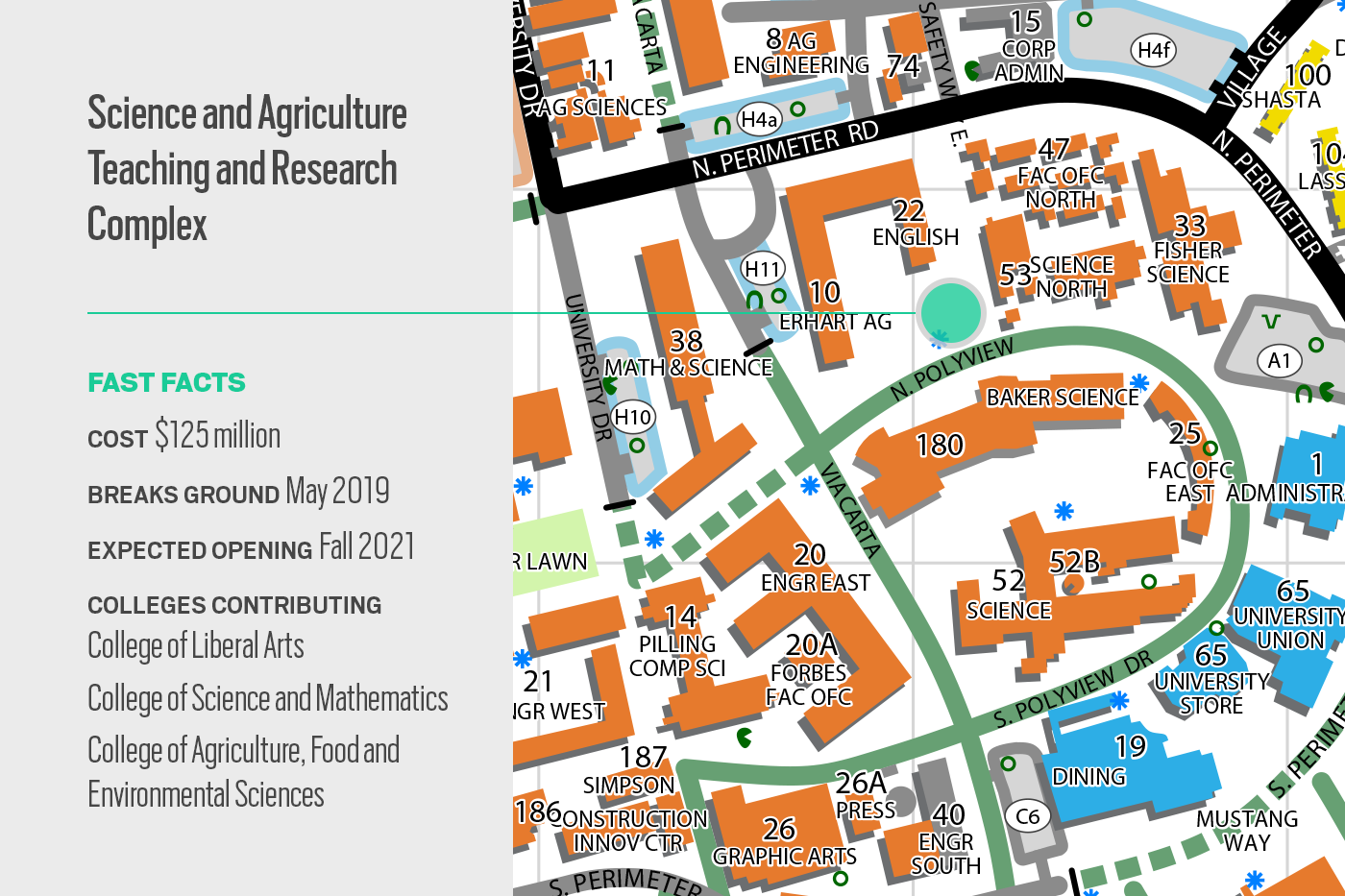Cal Poly will break ground on a new $125 million, four-story interdisciplinary research building beginning May 2019. The first phase of construction is expected to be completed by Fall 2021.
The 100,000-square-foot Science and Agriculture Teaching and Research Complex (SATRC) is a collaboration between the College of Liberal Arts, the College of Science and Mathematics and the College of Agriculture, Food and Environmental Sciences. It will stretch roughly from the Cal Poly Plant Conservatory to Clyde P. Fisher Science Hall (building 33).
The Science North Annex (building 53A) will be demolished to make room for the new complex. However, everything but the plant conservatory and vivarium will be included in the SATRC. University President Jeffrey Armstrong said the plant conservatory and vivarium will be relocated and rebuilt, but the university is still working on securing funding.
An atrium will extend through all four stories in the center of the complex, according to Cal Poly Facilities Planning and Capital Projects. The first floor will include a lecture hall, classrooms, a computer lab, project space, a culinary laboratory and an area for electrical and mechanical equipment. The remaining floors will include faculty offices and laboratories.
Cal Poly officials are currently finalizing construction plans for the 3.5-acre complex.

“It is right at the center of campus in order to show that undergraduate research is an important part of Cal Poly’s values,” Director of the Frost Fund Phil Bailey said.
Bailey is the former Dean of the College of Science and Mathematics and has been working at Cal Poly for 50 years. He also spearheaded the development of the Warren J. Baker Center, the last major academic building to be added to campus.
“Our mission is education, and research is a tool to educate our undergraduates for their future careers,” Bailey said.
The complex will house a new agricultural technology center named after Jim Boswell, a Cal Poly alumnus who contributed $10 million towards the project. The Center for Expressive Technologies (CET) for the College of Liberal Arts will also be relocated to the building.
According to Director of the Center for Expressive Technologies Matthew Harsh, it will act as a creative space that supports interdisciplinary work focusing on technology and human expression. Faculty are looking to include innovations in the center such as performance capture technology, augmented reality, cinema, animation and interactive elements.
“The idea is to create a developmental and experimental space to work with types of emerging technology in interesting ways,” Director of the Liberal Arts and Engineering Studies Program David Gillette said. “We want to also have a global component where we can connect this space to different spaces around the world.”

The first phase, which is the largest component of the building, will cost around $100 million. This money has already been raised, and the first portion of the building is scheduled to open Fall 2021.
More than half of the $100 million allocated to the building is from donations, Armstrong said.
“We could not do this without the gracious support of our donors. Without them, it would be impossible to build these specialized facilities,” Armstrong said.
Additional funding includes $10 million from The California State University (CSU) for classrooms, as well as funding from the Cal Poly Corporation and colleges involved.
“If you think about what the state will fund, they have to fund buildings at 23 campuses,” Armstrong said. “There’s not enough money for the CSU to fund 100 percent of specialized undergraduate research building — they fund libraries and classrooms. They have to focus on the main mission.”

Included in these donations is money from the highest donation ever made in CSU history — the William and Linda Frost Fund. Alumnus William Frost and his wife Linda Frost donated $20 million to the SATRC from their $110 million undergraduate research grant in May 2017.
“The whole point of Mr. Frost’s gift is to grow undergraduate research in order to promote student success,” Armstrong said. “But you need brick-and-mortars to go along with the money and a place for them to do the work.”
The second phase of the building will include labs for the College of Science and Math, which will cost $24 million, Armstrong said. Cal Poly is working to continue fundraising for this portion of the building, in addition to rebuilding the conservatory and vivarium.
“I am confident that we will reach the total $125 million that is needed for this project,” Armstrong said.
Physics senior Luc Bouchard, who was granted a scholarship through the Frost Fund, said he hopes the new building will do as promised and promote undergraduate research.
“I think that undergraduate research opportunities are super valuable,” Bouchard said.“I would hope to see it allowing more students to get involved in more cutting edge research. That’s the main thing for me, allowing students to get involved with research they will later be getting involved in during their professions.”
There will be a groundbreaking ceremony for the SATRC on May 3 at the evening of Green and Gold.
Editor’s Note: It was clarified that the Science North Annex (building 53A) will be demolished, not all of Science North. The map has been updated to clarify the building’s location.

